Top 11 Magnificent Ancient Greek Architecture & Buildings
Ancient Greek architecture is still renowned nowadays for its simplicity and harmonious proportions. This population was so skilled in this art that its work influenced most of the following architectures, especially the Roman and Hellenistic ones.
The Greek civilization flourished between 1200 BC and 323 BC and was very advanced. Its first buildings were made entirely of wood, but from the seventh century onwards, this material was replaced with the more durable stone.
Greeks were also advanced in geometry and used several tricks to make their temples look perfectly straight. For instance, some of the columns would sometimes lean inward to create an optical illusion. Even nowadays, this architecture is almost invisible to the naked eye.
Throughout the years, this civilization built several temples and theaters, some of which were so well designed that can still be admired nowadays.
Here is a list of the 11 best-preserved ancient Greek buildings that reflect the architecture of ancient Greece!
1. Parthenon
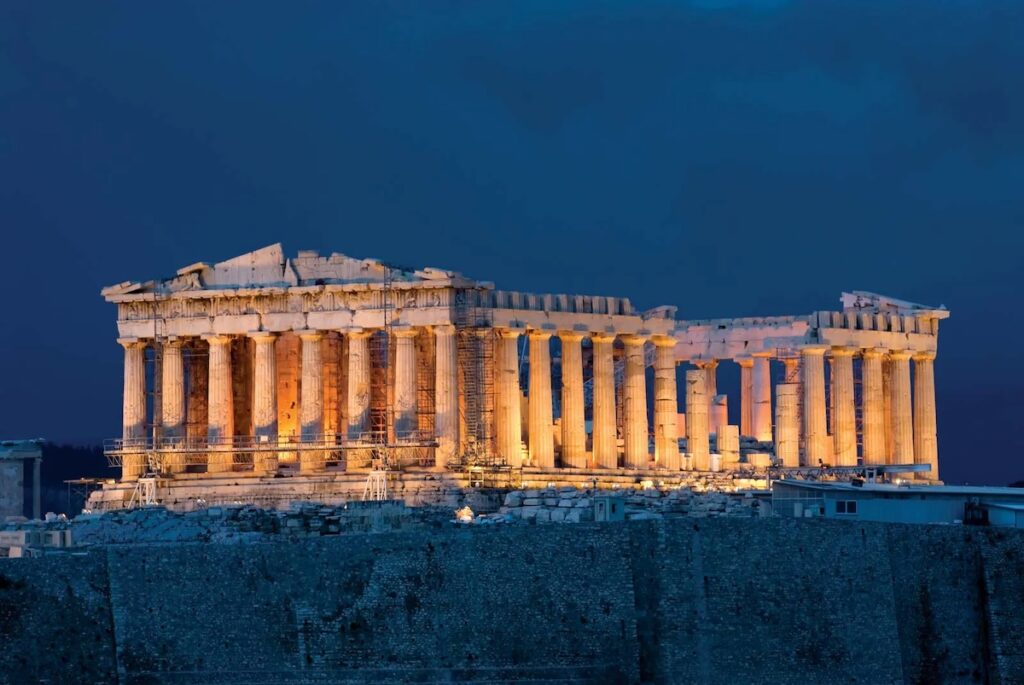
The Parthenon is the most iconic temple of ancient Greek architecture. Sitting at the very top of Athens, on the highest point of the Acropolis, this temple has survived wars, fires, explosions, and even earthquakes! But let’s start from the beginning.
Before its construction, the city of Athens already had a similar temple located in the same area. Known today as the Old Parthenon, this building was unfortunately destroyed by the Persians who attacked the city in 480 BC.
But Athens needed a sacred place to worship its patroness Athena, the Olympian goddess of wisdom and war. So the Greeks did not wait too long to rebuild their temples.
In 447 BC, Pericles summoned the renowned architects Ictinus and Kallikrates as well as the sculptor Phidias and ordered them to build a new Parthenon. It took only 15 years to build this stunning temple despite the limited resources available at the time.
The new Parthenon was entirely made of marble and, despite its appearance, did not contain straight lines. You may think we’re lying, but this is actually the truth!
In fact, Ictinus and Callicrates added subtle distortions called ‘optical refinements’ to make the structure look as straight as possible. If you pay attention, you will surely notice that the columns are slightly tapered.
The Parthenon served as a Greek temple till the sixth century AD when the Christian Byzantines conquered the city and turned it into a Christian church.
The Parthenon also served as a mosque in later times with the arrival of the Ottoman Empire in 1458. Today this building is one of the most popular attractions in Greece with 7.2 million people visiting every year.
2. Ancient Theater at the Asklepieion of Epidaurus
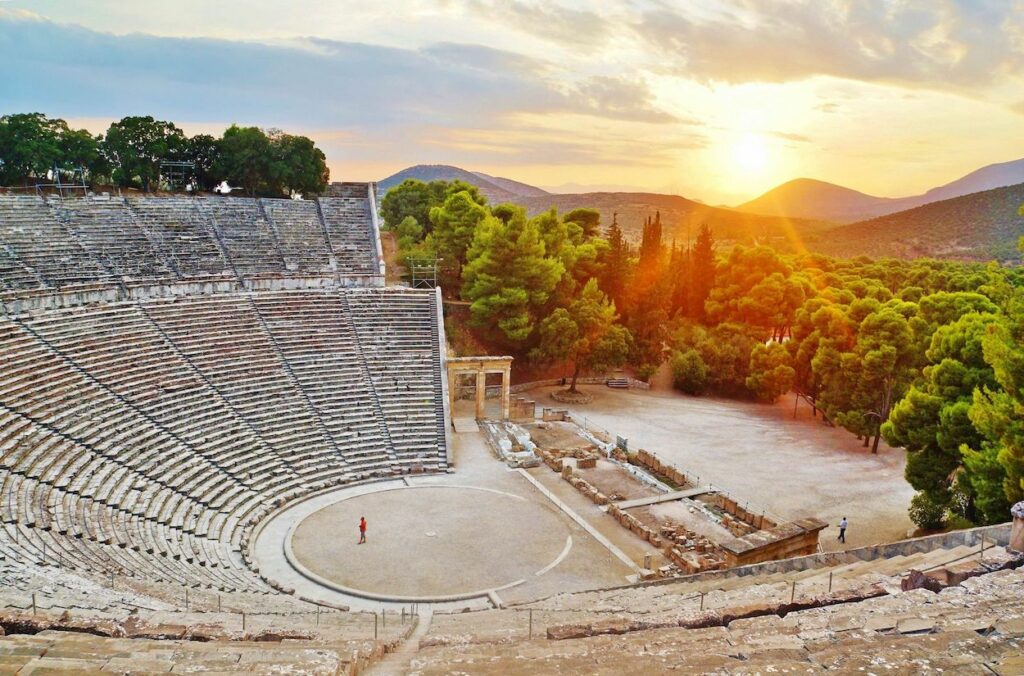
The Ancient Theater of Epidaurus is considered one of the finest theaters of all ancient Greek architecture. This impressive structure can welcome 13,000 spectators and, for decades, scientists could not understand how the Greeks managed to create such a perfect acoustic system.
In fact, people in the last rows can clearly hear the actors without microphones.
The Theater of Epidaurus was built on a mountain slope close to the sanctuary of Asklepios. This sanctuary was well-known in ancient Greek as people would travel for days to reach this site, hoping that its priests would cure their illnesses.
Given the popularity of this site, its priests soon decided to add new extra facilities. Some of these included athletic venus, baths, and, obviously, the Theater of Epidaurus.
The theater was designed by Polykleitos the Younger and was built in two phases. The first one took place in the 4th century BC and the second in the 2nd century BC.
The theater has a stage with a diameter of 20 meters and is divided into two main areas. One was used to welcome priests and authorities, while the other was designed for the common citizens.
For years this site has been buried by the lush vegetation of the area and only in 1881 it was uncovered thanks to some excavations.
After its discovery, several studies were carried out to find out how its acoustic system worked. At first, scientists thought it was due to its location on the slope of a mountain but, in recent years, it was discovered that the seats themselves act as acoustic traps filtering background noises.
Today this theater is still used during the Epidaurus Festival, during which ancient Greek plays and modern shows are performed on its stage.
3. Temple of Concordia, Agrigento
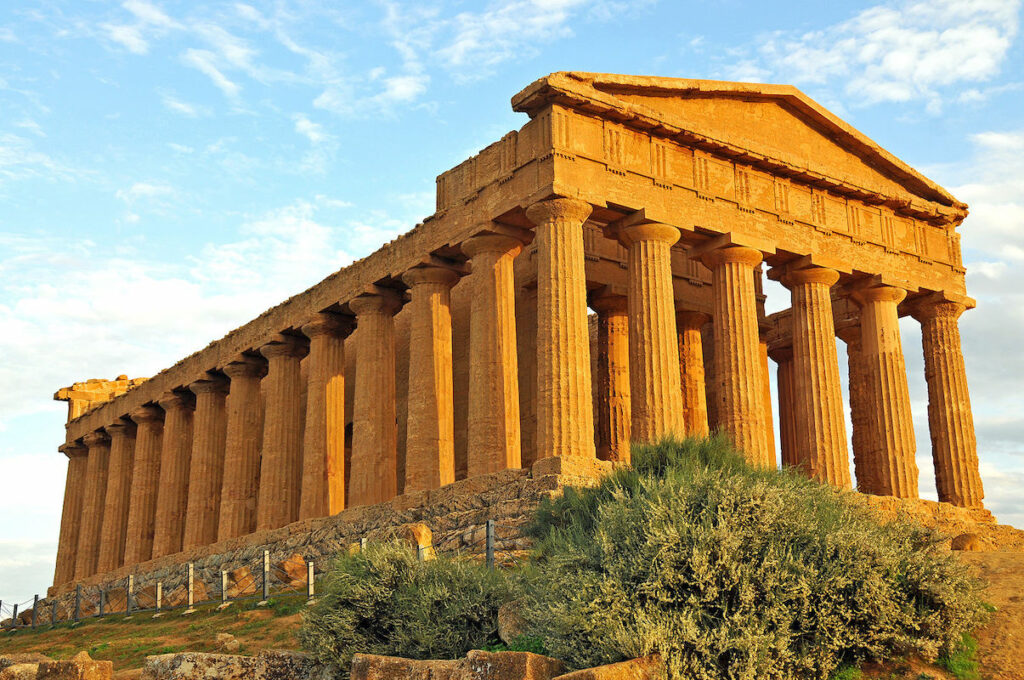
Greek temples are not only in Greece! This ancient population managed to conquer several lands, outside of its territories, including Sicily.
Sicily is an Italian island located at the center of the Mediterranean Sea. The Greeks arrived here in the 8th century BC and soon started to build several temples and amphitheaters.
The Temple of Concordia, located in the Valley of the Temples, is one of the most popular ones. Its construction started in 340 BC and ended ten years later in 330 CB. The building has a total of 79 columns and, together with the Pantheon, is one of the best-preserved Doric temples in the whole world.
Despite being called the Temple of Concordia, a Roman deity embodying harmony, we are now sure it was originally dedicated to a different goddess.
An inscription carrying Concordia’s name was in fact found next to the temple, but there seems to be no connection between the two.
4. Temple of Athena Nike
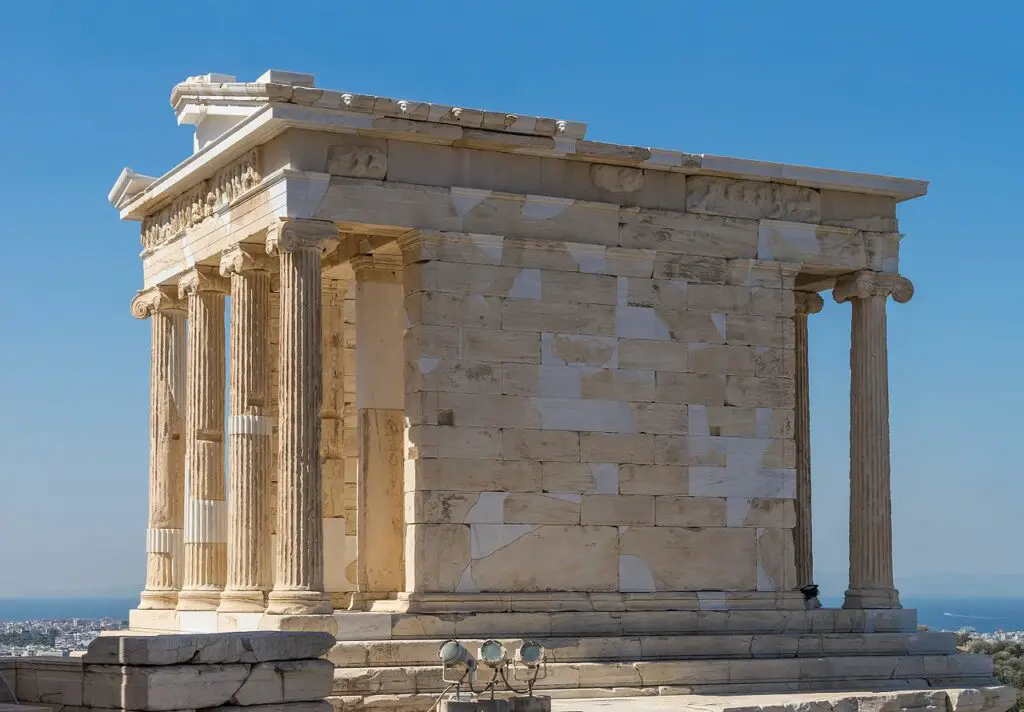
The Parthenon is not the only temple in the Acropolis! There are plenty of other buildings in the area, one of which is the Temple of Athena Nike. This is the smallest structure in the Acropolis and was built by the same architect who designed the Parthenon, Kallikrates.
The Temple of Athena Nike has a particular style known as amphiprostyle. This means that it features columns only on the front and back and not on the side of the cella, a term used to refer to a chamber located inside the temple.
People at the time were not allowed to enter this sacred space and only priests had the honor of seeing its interiors. However, a small altar was located outside of it so that the citizens of Athens could perform their rituals there.
People would often come here to worship Athena Nike, the goddess of victory in art, sports, music, and war. Many scholars believe that this temple was dedicated to her after the victory of the Greeks in the Greco-Persian Wars.
In ancient times, a big statue representing this goddess was located in the temple; however, unlike other ones, it did not have a pair of wings. This was done to prevent her from flying away from Athens and stop protecting the city.
5. Temple of Olympian Zeus
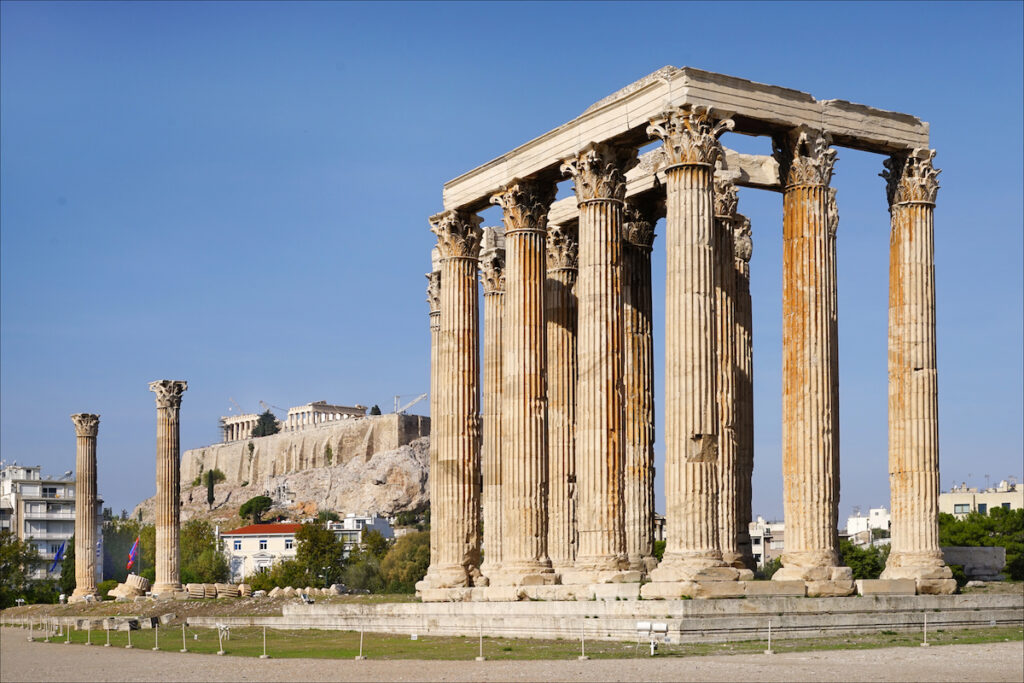
In the middle of the busyness and traffic of modern-day Athens, it is still possible to admire the Temple of Olympian Zeus. Surrounded by a green park on all its sides, this is one of the many temples in the city located outside of the Acropolis.
The history of the construction of this site is quite intricate and it took centuries before the building was finally completed.
Construction works began in 520 BC under the order of the tyrant Peisistratus and his son. When they died, however, the temple was left unfinished.
Nobody took care of these ruins for a few hundred years until the 2nd century BC, when one of Athens’ benefactors, Antiochus IV Epiphanes, decided to donate money to complete the temple. He hired a Roman architect, Decimus Cossutius, to build the columns in the Corinthian order.
This means that the capitals of the temple’s columns were not as simple as the ones in the Doric order but were decorated with leaves and flowers. Unfortunately, Antiochus soon died, and the Temple of Olympian Zeus remained unfinished.
The building was completed only in 131 AD with the arrival of the Roman Emperor Hadrian.
6. Temple of Apollo, Delphi

The Temple of Apollo in Delphi was one of the most famous in Ancient Greek, and plenty of people traveled all over the country to visit this site. It was built on the slopes of Mount Parnassus, and its ruins can still be admired nowadays.
Just like many other temples, its construction was quite turbulent. The first structure was built in the 7th century BC but was soon destroyed by a fire. The temple was then rebuilt in the 6th century, but an earthquake knocked it down again in 373 BC.
The building was erected a third time in 370 BC by three architects from Corinth: Spatharos, Exnodoros, and Agathon. Several statues were also added by the Athenian sculptures Praxis and Androsthenes to adorn the site. Thankfully, this was the last time the temple had to be rebuilt, but not according to legends!
The Greek traveler Pausanias reports that the temple had to be erected five times. According to his story, the Greeks first built the temple using bay tree branches, while the second structure was made out of beeswax.
The temple was then rebuilt a third time by Hephaestus himself, the god of craftsmen, using bronze. But it soon fell into a giant hole that mysteriously appeared underneath it.
The fourth temple was designed by three architects who mysteriously died after three days from the beginning of the works, and the fifth building is the one that we can still admire nowadays.
7. Temple of Hephaestus, Agora
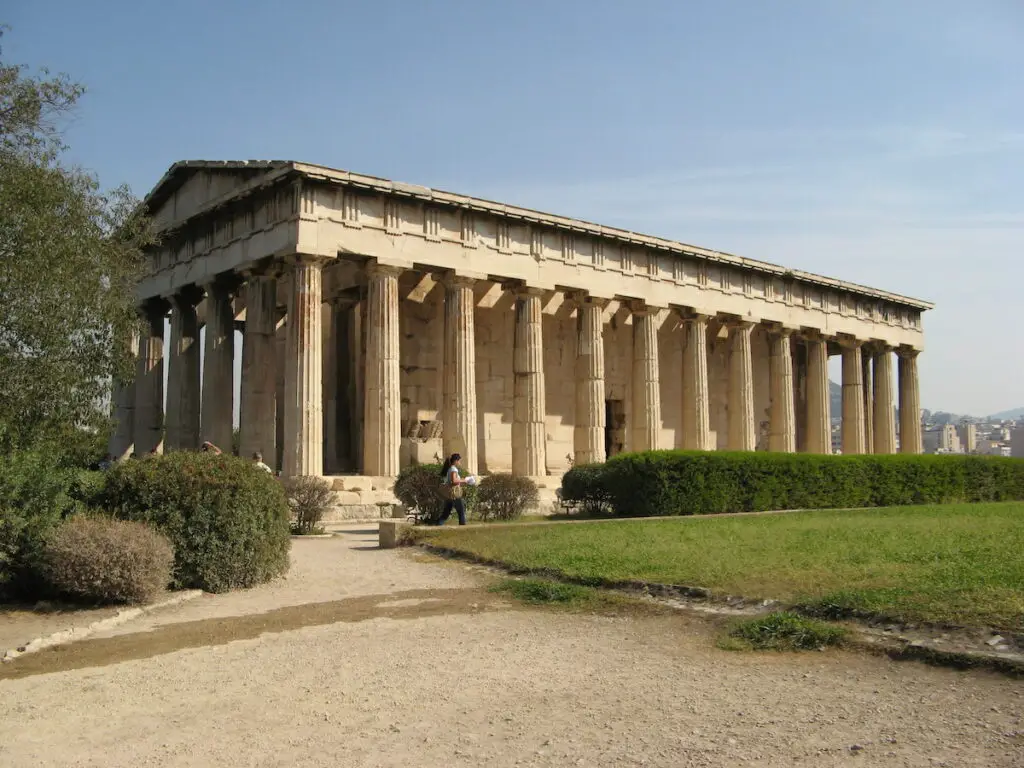
Built around the same period as the Parthenon, the Temple of Hephaestus was dedicated to the god of fire, craftsman, and metal.
Its construction started in 449 BC under the order of Pericles and ended 30 years later. This was mainly because the architect Iktinus and most of the funds devoted to the site were temporarily directed towards the construction of the Parthenon.
When it was finally completed in 415 BC, the temple measured 31.78 per 13.71 meters and featured marble from the nearby Mount Penteli.
At the time, the Temple of Hephaestus also had an inner colonnade at the end of which stood two bronze statues, one representing Hephaestus and the other one Athena, the goddess of wisdom, war, pottery, and crafts.
This may be the reason why, in recent times, archeologists have found plenty of ancient Greek pottery and crafts surrounding this site.
The Temple of Hephaestus is one of the best-preserved Greek temples that can still be admired nowadays, as, during the Middle Ages, this site was used as a church.
8. Temple of Poseidon
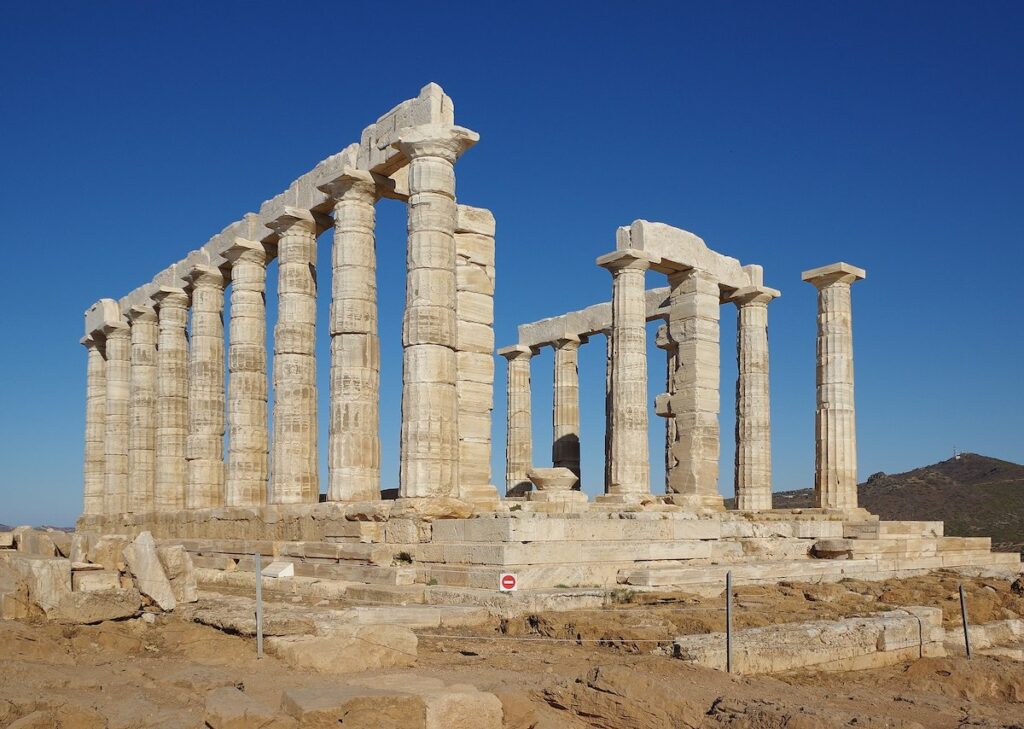
The Temple of Poseidon is a stunning building located on the top of a 60-meters cliff facing the Aegean Sea. This temple was dedicated to Poseidon, the god of seas, storms, and earthquakes.
This structure was probably built between 444 BC and 440 BC and was designed by Iktinos, the same architect who worked on the Temple of Hephaestus. If you look at the temple you will surely notice that its columns get thinner on the top. This was done to make them look taller than they actually were.
The Temple of Poseidon is also known for King Aegeus. This is in fact the site where he killed himself because of a terrible mistake.
According to the legend, King Aegeus reached the top of this cliff while waiting for the return of his son, Theseus who had left his motherland to fight the frightening Minotaur. Before the departure, Theseus and his father made an agreement.
If the Minotaur would have killed Theseus, the vessel had to return with black veils, while white veils would have been a sign of victory. Despite his success, Theseus forgot to change the veils on his returning trip and his father, seeing the black veils approaching, decided to kill himself by jumping off the cliff.
9. Temple of Hera
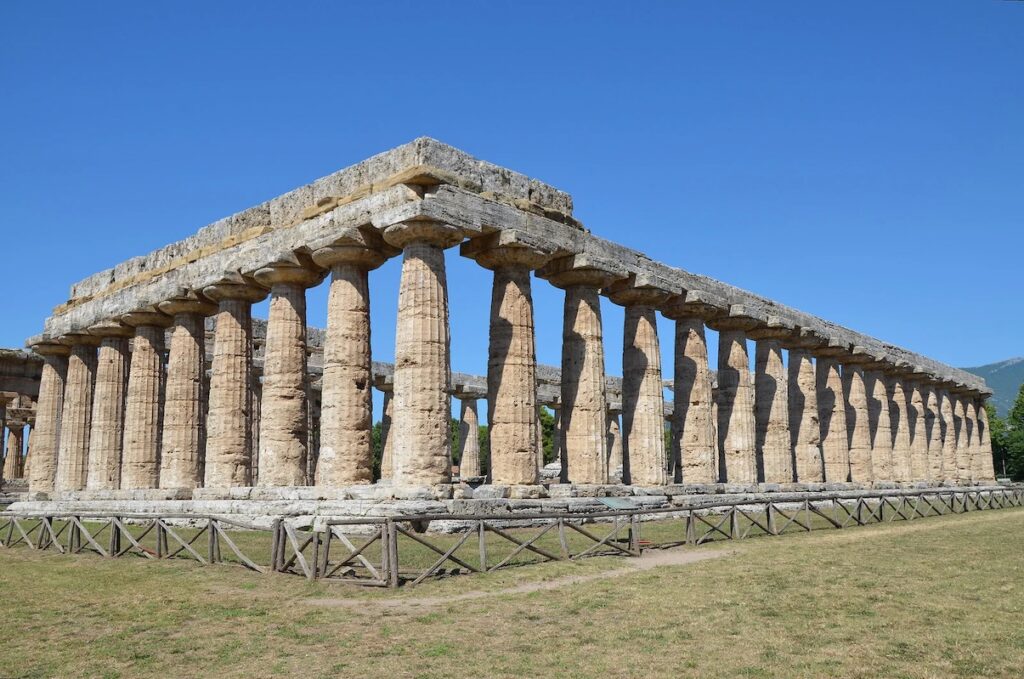
The Temple of Hera is located in the archeological site of Olympia. This structure was built in the 7th century and initially was entirely made out of wood, which was later replaced by stone.
The Temple of Hera is particularly famous for its role in the Olympic games. In fact, this is the place where the Olympic flame was first lit. Historians also think that, in ancient times, the Disk of Iphitos, which marked the beginning of the Olympic games, was kept here.
The Temple of Hera was built according to Doric architecture and had 16 columns. Experts believe that in the beginning it only consisted of a room and a corridor, and extra structures were added in later times. The lower part of the temple used to be made of limestone, while the upper one was built with mud bricks.
During Roman times, this site was used as a sort of museum, and plenty of valuable treasures were kept inside. Unfortunately, only a few columns have survived the passing of time.
10. Erechtheion
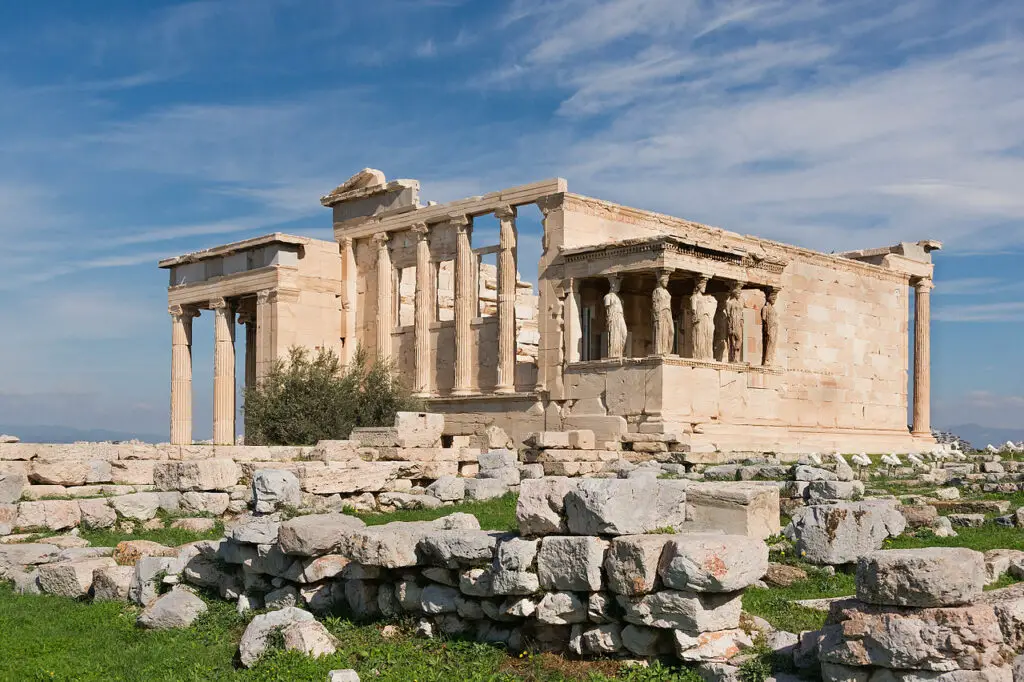
The Erechtheion is one of the many structures built in Athens after the Persian Wars to re-established the importance of the city. Its construction began in 421 BC and was completed only in 406 BC, under the supervision of architect Philocles.
The Erechtheion was erected to worship a massive wooden statue of Athena, which was kept inside the temple. But it also had a second function. It served as the center of the cult of several demi-gods, such as Erechtheus, from which it got its name.
Erechtheus was a mythical Athenian king who was considered responsible for founding the polis, a term referring to a city-state in Ancient Greek. But at the Erechtheion, people also worship other demi-gods, for instance, the mythical King Kekrops, a half-man and half-snake being, who was thought to be the first king of Athens.
Like many other temples in Athens, the Erechtheion is made with Pentelic marble. However, this structure also contained iron that oxidized through time, giving the temple its unique honey color, which can still be seen at dawn and sunset.
11. Theater of Delphi

The Theater of Delphi is another stunning ancient Greek structure that we can luckily still admire nowadays. Despite its wonderful architecture, the most astonishing feature of this site is its location.
The 5,000 spectators who used to come here to watch local plays and dramas had to really focus to follow the plot and ignore the breathtaking vista that could be enjoyed from their seats.
The theater was built in the 4th century BC and has 35 rows. Some of the seats are still marked with ancient Roman numbers, while others have engravings such as ‘amphictyonon’, meaning ‘belonging to the member of the amphictyonian council’.
Historians have also found names of popular individuals who had their own reserved seats for each performance.
Conclusion
The ancient Greeks were masters of engineering and architecture. From the simple dwellings of early farmers to the magnificent temples of classic Athens, Greek architecture is renowned for its elegance and symmetry.
Ancient Greek buildings and architecture have also made a significant contribution to the development of city planning and other aspects of urban planning. Indeed, many of the buildings that stand up remain highly influential in the field of architecture today.
How to Cite this Article
1. To cite this article in an academic-style article or paper, use:
Cristina Miceli, “Top 11 Magnificent Ancient Greek Architecture & Buildings”, History Hippo, July 2, 2022, https://historyhippo.com/magnificent-ancient-greek-buildings-architecture/. Accessed July 26, 2024
2. To link to this article in the text of an online publication, please use this URL: https://historyhippo.com/magnificent-ancient-greek-buildings-architecture/
3. If your web page requires an HTML link, please insert this code:
<a href=”https://historyhippo.com/magnificent-ancient-greek-buildings-architecture/”>Top 11 Magnificent Ancient Greek Architecture & Buildings</a>
